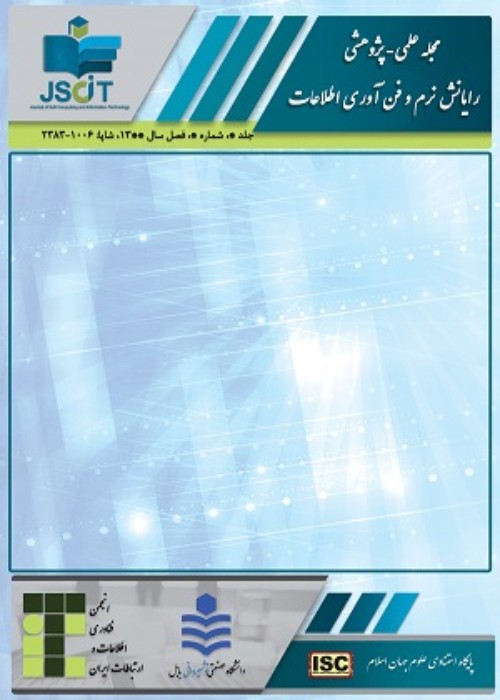فهرست مطالب

مجله رایانش نرم و فناوری اطلاعات
سال سوم شماره 4 (زمستان 1393)
- تاریخ انتشار: 1394/02/28
- تعداد عناوین: 7
-
-
Page 3localization demonstrates one of the most important research scope in terms of the wireless sensor networks since much of the information distributed by the sensors are important when including the localization problem. In the present study, two new methods for sensor localization have been proposed, which are indeed a compromise between rangebased and range-free techniques. In the proposed methods, the sensors make use of omnidirectional antenna for transmission of their usual information, and information processing is performed only through some sensors called landmark. The lack of need for complex processing, reduction in the energy consumption, and high precision in locating the geographical coordinates are among the most important features of the suggested protocols. Simulation results show that the proposed methods are highly efficient while reducing system’s complexity.Keywords: localization, wireless sensor network, landmark sensor, mother landmark
-
Page 10WirelessSensor Network (WSN) is one of the most important technologies of the XXI century whichis becoming the next step in information revolution. The WSNis divided in two main categories, Homogenous Wireless Sensor Networks and Heterogeneous Wireless Sensor Networks. Heterogeneous wireless sensor network consists of several nodes with different functions and characters. Minimizing the number of super nodes in these networks is one of the challenging issues. Several approaches have been presented to solve this problem up to now; such as Genetic Algorithm, Bee Algorithm, PSO Algorithm and etc. In this paper a novel meta-heuristic algorithm Cuckoo Search Algorithm (CSA), is introduced to solve this problem. The main contribution of this paper is to reach an optimum trade-off between the number of super nodes and network efficiency. MATLAB, simulation toolkit, is used to simulate the efficiency of this method. Simulation results show that proposed algorithm quickly finds a good solution and has better performance than Genetic based algorithm.Keywords: Heterogeneous Wireless Sensor Network, Cuckoo Search Algorithm, Optimization Algorithm, Meta, heuristic
-
Page 21In this paper an optimized pole shape is presented to reduce acoustic noise of switched reluctance motor (SRM). The optimization is based on the genetic algorithm and by considering both radial force and torque ripple reduction. A two-dimensional (2-D) finite element (FE) analysis is carried out to simulate the 6/4 SRM for each solution of the population generated by GA. To decrease the acoustic noise in SRM, arcs on the rotor and stator teeth are designed in three steps including: rotor with arcuate teeth, stator with arcuate teeth, and both stator and rotor with arcuate teeth. In the case of the stator with arcuate teeth, torque ripple and radial force decrease in comparison with the base motor while the average torque for this model is the same as the base motor. In the case of the rotor with arcuate teeth, torque ripple increases and radial force decreases. However, the radial force and torque ripple might be varied in the same or opposite direction. The best solution produced by the GA has been implemented on a real motor. Experimental results on a real motor demonstrate the validity of our proposed GA based optimized pole shape.Keywords: Switched reluctance motor, Genetic algorithm, Radial force, Torque ripple, Acoustic noise
-
Page 29This paper presents a binary particle swarm optimization for optimally determining the size and location of distributed generation (DG) and capacitor in distribution systems. The main innovation of this paper is using both of DG and capacitor for the reliability improvement and power loss reduction. For this purpose an objective function consisting of reliability cost, power loss cost and also DG''s and capacitor''s investment cost are considered. The effectiveness of the proposed method is examined in the 10 and 33 bus test systems and compared with genetic algorithm method. The results obtained show appreciable reliability improvement and loss reduction while simultaneously using DG and capacitor.Keywords: Distributed generation, Capacitor bank, Loss reduction, Reliability improvement, Binary particle swarm optimization
-
Page 38In this paper, a new current mode four-quadrant analog multiplier circuit is proposed. The circuit structure is based on dual trans-linear loops. The new structure used in the circuit shows more promising features for the purposes of lower power consumption, wider bandwidth (BW), and lower Total Harmonic Distortion (THD). The structure of the circuit is such that it is almost independent of process, temperature, and supply-voltage, PVT, variations. In addition, the circuit was optimized using Multi-Objective Genetic Algorithm (MOGA) and the results demonstrate the power of this tool in the optimization of electronic circuits. The designed circuit with 1.8 V supply voltage and 53 μW power consumption, results in 1.503 GHz BW, 0.53% THD (in 1 MHz frequency) and also 0.84% maximum nonlinearity error.Keywords: Current Mode Analog Multiplier, Translinear Loops, Evolutionary Algorithms, Multi, Objective Optimization
-
Page 48This paper presents a method for constructing a Radial Basis Function network based on normalized cut clustering for determining center and width of Radial Basis Functions. Normalized cut clustering can separate clusters that are non-linearly separable in the input space, so it can be able toconstruct an RBF network classifier with reduced number of hidden layer neurons in comparison with conventional RBF network obtained by k-means method. The well known pseudo inverse method is used to adjust the weights of the output layer of RBF network. Quantitative and qualitative evaluations show that the proposed method reduces the number of hidden units and preserves classification accuracy in comparison with conventional RBF network generated by k-means method.Keywords: radial basis function networks, normalized cut clustering, center, width of Radial Basis Functions, number of hidden layer neurons
-
Page 55Stock market is known as a stochastic, nonlinear, and uncertain environment. Hence, decision making in its trading is a challenging task. Indeed, stock markets are influenced by many parameters such as stock market indicators, micro-economic and macro-economic parameters and news articles. The latter is known as one of the effective parameters, attracting analysts’ attention in recent years. If news could be successfully analyzed, predicting the stock market’s reaction to the news would be achievable. This paper proposes an intelligent decision support system for trading stocks, based on news in Tehran Stock Exchange. Here, instead of predicting stock prices, we predicted the trend of stock prices. To this aim, text mining was used to extract several types of features from the news. Afterwards, the most effective features were selected and then provided for Support Vector Machine (SVM) in order to be classified as a positive or negative trend. Based on comparison of several types of features we concluded that the word combination is the best solution for Farsi. The simulation results depicted that stock trend prediction is successful and profitable in many cases. Moreover, due to linguistic similarities between Farsi, Arabic and Urdu, having some powerful stock markets of the world, our proposed intelligent algorithm could pave the way for data analysis in those languages.Keywords: Text mining, Stock price, Intelligent trend prediction, News, Farsi


